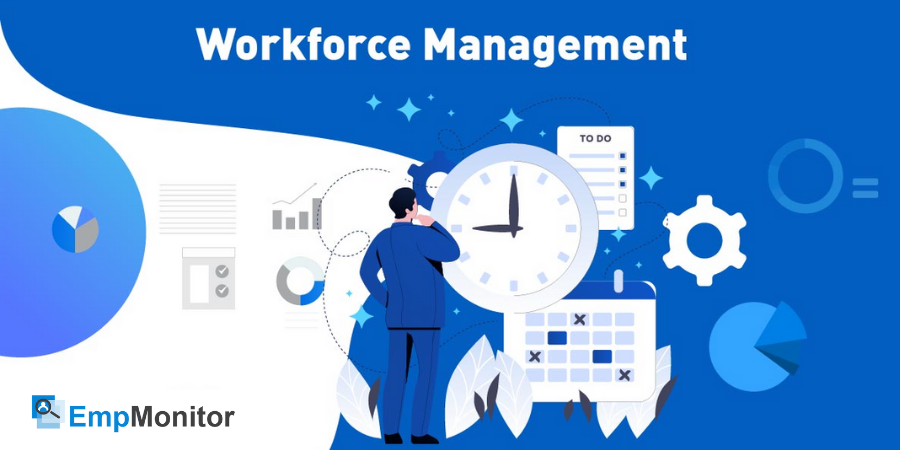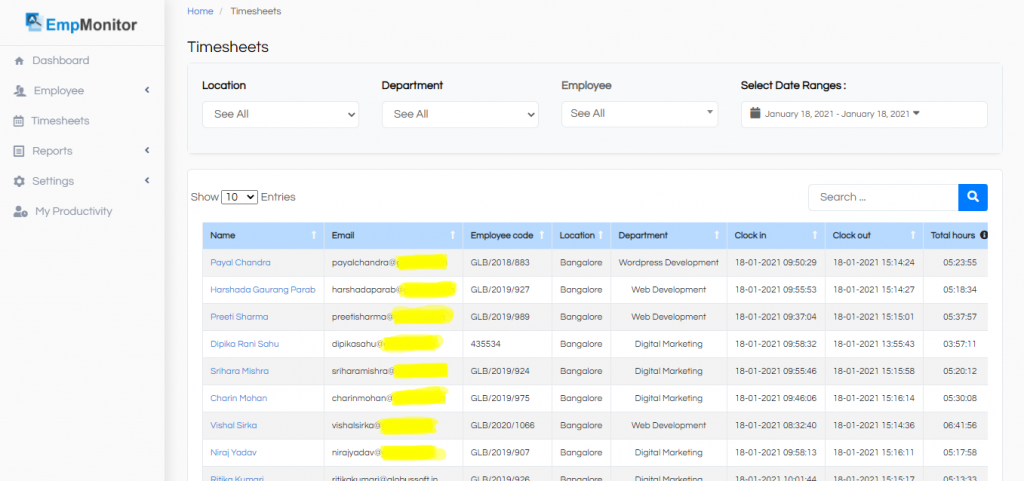Information technology has brought us enhanced labour solutions, today’s management has more freedom to focus on higher-level company concerns.
This era makes use of fully automated and integrated workforce solutions for management and workforce optimization system. It has not only made labour management easier, but it has also changed workforce management methods. It has revolutionised every facet of managing the whole worker lifecycle.
It’s been a long road for workforce management.
By looking at labour management from the beginning, the mysteries of workforce management can be revealed. What were the methods of workforce management in previous eras, and how did they change?
What is workforce management?
A new era of workforce management innovation has arrived, with a plethora of workforce management solution options claiming to handle all of the activities required to keep a productive staff.
To comprehend workforce management, it is necessary to first grasp workforce and management separately, and then collectively.
The people engaged in or available for labour, either in a country or territory, or in a certain enterprise or industry, according to the Oxford Dictionary. The pool of labour employed by a firm, an industry, or a country is referred to as the workforce.
“Management” -This work can be found in ancient writings such as Kautilya’s Arthshastra (300 BC), Niccole Machiavelli’s The Prince (16th Century), and Adam Smith’s The Wealth of Nations (18th Century). Since the long history management has been a part of human work culture.
And this further developed via technological and scientific solutions. Now the process of management and leadership has become far easier compared to those old days.
In simple words- management is described as “the organisation and coordination of a company’s activities in order to achieve set goals.”
The widely held belief in management is that it is about getting the job done and succeeding at it by managing and coordinating other people, things, and situations.
There are two things to consider: the workforce and management. They are the only two elements that actively operate a firm.
“Once employees have been hired, the “workforce” must be managed so that they are aware of their responsibilities. Scheduling employees’ work hours, organising work tasks and obligations, working as a team, and tracking the results of work efforts are all common areas of concentration. Employee relationship management is another term for it.”
The practise of managing a workforce is known as workforce management. Maintaining other elements of the business in parallel while keeping the firm’s goal in the forefront, with the goal of workforce optimization.
The term “workforce management” refers to the management of a group of people.
Workforce Management includes:-
- Work analysis
- Forecasting and scheduling
- Job design
- Talent acquisition
- Keeping track of time, attendance, and absences
- Benefits and compensation
- Workforce administration (work and culture discipline)
- Management of performance
- Planning for career advancement and succession
- Management of learning and training
Worried about how to manage your personnel? EmpMonitor can help.
EmpMonitor (Employee Monitoring Software)
Manage and Monitor all your remote employees from a Single Dashboard
Manage all the computers in your organization remotely from a centralized location. Your EmpMonitor account is accessible from any internet-enabled device giving you access from anywhere at any time. With our real-time computer monitoring software, you can view activities as they happen and manage instantly.
Time Management
- Track employees performance, presence and activities
- Spot and eliminate wasted time
- Optimize your team
User Management
- Effectively manage multiple systems and users
- Centralized network monitoring
- Deputize your Peers
Get Real Time Insights
- See what your employees are doing in real time
- Live Refresh mode
- Department level management
Manage Attendance
- Log hours from anywhere (Flexible user based settings)
- Accurate work hours
- Department wise attendance
- Extract ready-made reports (up to 30 days)
Auto Screenshots
- Take screenshots at regular intervals
- Customized monitoring parameters
- Generate random screenshots
- Make sure Employees stays on track
Why EmpMonitor Is Best For Your Business?
EmpMonitor can improve your employees’ productivity, business, and overall operation with its various amazing functionalities. These are just a few ways.
1- Increase productivity
2- Data security
3- Graphical Reports
4- Stealth operation
5- Save time and money
6- 24/7 support
What are the advantages of employing a workforce management system?
Other WFM (workforce management) advantages include increased payroll efficiency due to the automation of time-consuming, frequently complex processes and duties. Employers have a greater understanding of employee engagement, attendance, and productivity, allowing them to alter training, coaching, and processes to achieve optimal results. Labor cost minimization and optimization.
Task supervision is another important aspect of workforce management.
When and who does what? What duties are the most important? How can you ensure that everything is completed on time and to the highest standards?
The answer to those inquiries can be found in your WFM software’s task management feature
For example, EmpMonitor helps you boost employee productivity on the job by keeping your team on track and organized for the task you’ve given them.
This not only results in better customer service and a happier workplace, but it also results in higher profit margins and revenue, which can help your company develop.
Sling is another software with task oversight features. Based on the premise that assignments should be specific, measurable, achievable, relevant, and timely (the SMART management theory).
Using Sling’s task oversight function and those five criteria, you can:
1-Maintain daily clarity and alignment among your personnel.
2-Set high standards for yourself.
3-Provide instructions that may be accessed from any device.
4-Follow up on work progress and give early and frequent feedback on performance.
5-Templates for repeated tasks can help you save time.
6- Across all sites, keep an up-to-date organisational checklist.
7- Gain insight into staff productivity and performance.
8- Create a culture of trust and empowerment.
9- Make it clear what the penalties and incentives are.
What does workforce management software entail and what does it accomplish?
Workforce management (WFM) software is a catch-all word for desktop and mobile tools that assist a company with employee scheduling. The word came from call centres and other service organisations that employ a high number of hourly workers. WFM software’s purpose is to provide visibility into business metrics, for example as the smallest number of agents required at a specific time of day or the length of time it takes to manufacture a specific product.
What is Work from Home?
Working from home (WFH) refers to an employee who works from their home, apartment, or other place of residence rather than from the office. Many businesses have a WFH policy, or remote work policy, that permits workers to work from home full-time or as needed.
Coworkers can interact and stay in contact no matter where they are thanks to video conferencing tools and collaboration technology. WFH jobs can even be totally remote, allowing employees to work from home every day. WFH employees frequently have a home office or dedicated workspace where they can concentrate and be productive.
Working from home expands the number of options available to organisations in terms of how they operate and structure themselves. With the onset of the coronavirus (COVID-19) pandemic, home working has provided some employers the flexibility they need to keep their businesses running while prioritising the health and well-being of their employees and customers as part of their public health responsibilities
Working from home was on the rise prior to the coronavirus epidemic, as many firms recognised the benefits to their businesses and improved work-life balance for their employees. Even if you don’t think working from home will benefit your firm, employees with 26 weeks of service have a legal right to request flexible work arrangements, such as working from home.
WFH Management has advantages as well as disadvantages:-
Advantages of employees working from home:-
Flexibility and agility – working from home allows for more flexibility and agility in working arrangements. Employees may be better positioned and more willing to work flexible hours, such as earlier or later in the day, or even on weekends, if they are no longer tethered to an office. This could assist you in meeting specific company needs, such as trading with consumers in a different time zone.
Financial advantages– include cost savings on office space, supplies, power costs, and other services. Employees may also be able to take advantage of HM Revenue & Customs (HMRC) tax savings for working from home.
Increased productivity – as a result of fewer interruptions than in an office environment. Working from home, on the other hand, provides a quieter environment that allows for more focused work. Employees may also work longer hours since they can use the time saved from commuting to begin work earlier, later, or both.
Fewer sick days – employees who work from home are more likely to be happy and energised, which means their immune systems are less likely to be harmed by burnout. Additionally, because staff work in isolation, there is a lower risk of infection spreading than there would be in an office setting.
Convenience – You may have employees who make frequent visits to customers’ locations and hence are not in the office on a regular basis. Allowing them to work from home could be more convenient and result in further time and expense savings.
There’s less of a need for regular vacations– because working from home might feel like a break from the business, even though employees are still on the clock. Working from home employees will feel more energised and will be able to spend more time with their families, reducing the need for vacation time. It is, nevertheless, your responsibility as an employer to guarantee that employees take their vacations.
Disadvantages of employees working from home
Working from home is not for everyone– and it may not be suited to everyone’s personality or abilities. Some employees may appreciate the routine and structure that comes with working in an office setting. Some employees prefer face-to-face engagement with coworkers and find that direct direction from their manager is incredibly helpful in completing tasks and achieving goals.
Difficulty managing and monitoring performance – controlling and monitoring the performance of home employees may be difficult. Different personalities may react to monitoring in a positive or negative way. You can consider defining measurable goals and targets for your employees so that if they don’t meet them, you can spot and address any performance concerns early on.
Detrimental impact on mental health – If your employees are unable to establish a schedule that works for them, are having difficulty separating work and home life, or are feeling lonely, the transition to working from home may have a negative impact on their mental health. To assist you, encourage your staff to establish a work schedule, create a dedicated workplace, and establish boundaries for other family members.
Poor broadband speeds – you should be aware that, depending on where your employees live, they may not be able to get broadband speeds that allow them to do their jobs properly, e.g., rural broadband is notoriously slow. Poor broadband speeds – keep in mind that depending on where your employees live, they may not be able to get broadband speeds that allow them to accomplish their jobs effectively.
Potential burnout – when an office provides a clear physical boundary between work and personal life, working from home can cause employees to lose sight of the distinction. Employees may find it difficult to decide when to leave work, resulting in longer hours, higher stress, and, eventually, burnout. Employers should encourage their employees to follow the rules.
This experience can be quite useful in determining the future direction of employees’ working practises.
Employees do not have to work exclusively from home as a result of the shift to home working. Splitting time between home and work is often the most productive answer, and you may want the homeworker to attend meetings to ensure that they are completely engaged and informed.
Also Read:
07 Ways To Build a Future-Ready Workforce
How Timekeeping App Helps You Stay Goal-oriented at Work


















